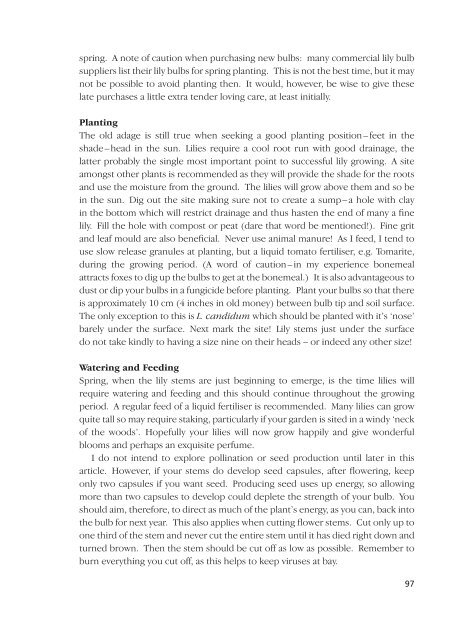Lilies and Related Plants - RHS Lily Group
Lilies and Related Plants - RHS Lily Group
Lilies and Related Plants - RHS Lily Group
Create successful ePaper yourself
Turn your PDF publications into a flip-book with our unique Google optimized e-Paper software.
spring. A note of caution when purchasing new bulbs: many commercial lily bulb<br />
suppliers list their lily bulbs for spring planting. This is not the best time, but it may<br />
not be possible to avoid planting then. It would, however, be wise to give these<br />
late purchases a little extra tender loving care, at least initially.<br />
Planting<br />
The old adage is still true when seeking a good planting position – feet in the<br />
shade – head in the sun. <strong>Lilies</strong> require a cool root run with good drainage, the<br />
latter probably the single most important point to successful lily growing. A site<br />
amongst other plants is recommended as they will provide the shade for the roots<br />
<strong>and</strong> use the moisture from the ground. The lilies will grow above them <strong>and</strong> so be<br />
in the sun. Dig out the site making sure not to create a sump – a hole with clay<br />
in the bottom which will restrict drainage <strong>and</strong> thus hasten the end of many a fine<br />
lily. Fill the hole with compost or peat (dare that word be mentioned!). Fine grit<br />
<strong>and</strong> leaf mould are also beneficial. Never use animal manure! As I feed, I tend to<br />
use slow release granules at planting, but a liquid tomato fertiliser, e.g. Tomarite,<br />
during the growing period. (A word of caution – in my experience bonemeal<br />
attracts foxes to dig up the bulbs to get at the bonemeal.) It is also advantageous to<br />
dust or dip your bulbs in a fungicide before planting. Plant your bulbs so that there<br />
is approximately 10 cm (4 inches in old money) between bulb tip <strong>and</strong> soil surface.<br />
The only exception to this is L . c<strong>and</strong>idum which should be planted with it’s ‘nose’<br />
barely under the surface. Next mark the site! <strong>Lily</strong> stems just under the surface<br />
do not take kindly to having a size nine on their heads – or indeed any other size!<br />
Watering <strong>and</strong> Feeding<br />
Spring, when the lily stems are just beginning to emerge, is the time lilies will<br />
require watering <strong>and</strong> feeding <strong>and</strong> this should continue throughout the growing<br />
period. A regular feed of a liquid fertiliser is recommended. Many lilies can grow<br />
quite tall so may require staking, particularly if your garden is sited in a windy ‘neck<br />
of the woods’. Hopefully your lilies will now grow happily <strong>and</strong> give wonderful<br />
blooms <strong>and</strong> perhaps an exquisite perfume.<br />
I do not intend to explore pollination or seed production until later in this<br />
article. However, if your stems do develop seed capsules, after flowering, keep<br />
only two capsules if you want seed. Producing seed uses up energy, so allowing<br />
more than two capsules to develop could deplete the strength of your bulb. You<br />
should aim, therefore, to direct as much of the plant’s energy, as you can, back into<br />
the bulb for next year. This also applies when cutting flower stems. Cut only up to<br />
one third of the stem <strong>and</strong> never cut the entire stem until it has died right down <strong>and</strong><br />
turned brown. Then the stem should be cut off as low as possible. Remember to<br />
burn everything you cut off, as this helps to keep viruses at bay.<br />
97




